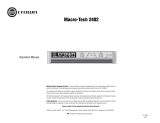
page 19
MA Series Power Amplifiers
Operation Manual
7.1 Overview
Your Macro-Tech amplifier incorporates several
advanced technological features including real-
time computer simulation of output transistor
stress, low-stress output stages, an advanced
heat sink embodiment and the PIP2 (Program-
mable Input Processor) expansion system.
Custom circuitry is incorporated to limit tem-
perature and current to safe levels, making it
highly reliable and tolerant of faults. Unlike
many lesser amplifiers, it can operate at its
voltage and current limits without self-
destructing.
Real-time computer simulation is used to cre-
ate an analogue of the junction temperature of
the output transistors (hereafter referred to as
"output devices"). Current is limited only when
the device temperature becomes excessive (and
by the minimum amount required). This pat-
ented approach is called Output Device Emula-
tion Protection (or ODEP). It maximizes the
available output power and protects against
overheating-the major cause of device failure.
The amplifier is protected from all common
hazards that plague high-power amplifiers
including shorted, open or mismatched loads;
overloaded power supplies, excessive tempera-
ture, chain-destruction phenomena, input over-
load and high-frequency blowups. The unit
protects loudspeakers from input and output
DC, as well as turn-on and turn-off transients.
The four-quadrant topology used in a Macro-
Tech's grounded output stages is called the
Grounded Bridge. This patented topology
makes full use of the power supplies providing
peak-to-peak voltages to the load that are twice
the voltage seen by the output devices (see Fig-
ure 7.1).
As its name suggests, the Grounded Bridge
topology is referenced to ground. Composite
devices are constructed to function as gigantic
NPN and PNP devices to handle currents which
exceed the limits of available devices. Each
output stage has two composite NPN devices
and two composite PNP devices.
The devices connected to the load are referred
to as "high-side NPN and PNP" and the devices
connected to ground are referred to as "low-
side NPN and PNP." Positive current is deliv-
ered to the load by increasing conductance
simultaneously in the high-side NPN and low-
side PNP stage, while synchronously decreas-
ing conductance of the high-side PNP and low-
side NPN.
The two channels may be used together to dou-
ble the voltage (Bridge-Mono) or the current
(Parallel-Mono) presented to the load. This fea-
ture gives you flexibility to maximize the power
available to the load.
A wide bandwidth, multiloop design is used for
state-of-the-art compensation. This produces
ideal behavior and results in ultra-low distor-
tion values.
Aluminum extrusions have been widely used
for heat sinks in power amplifiers due to their
low cost and reasonable performance. However,
measured on a watts- per-pound or watts-per-
volume basis, the extrusion technology doesn't
perform nearly as well as the heat sink technol-
ogy developed for Macro-Tech amplifiers.
Our heat sinks are fabricated from custom con-
voluted fin stock that provides an extremely
high ratio of area to volume, or area to weight.
All power devices are mounted directly to mas-
sive heat spreaders that are electrically at the
Vcc potential. Electrifying the heat spreaders
improves thermal performance by eliminating
the insulating interface underneath the power
devices. The chassis itself is even used as part
of the thermal circuit to maximize utilization of
the available cooling resources.
7.2 Circuit Theory
Each channel is powered by its own power
transformer T100 or T200. Both channels share
a common low-voltage transformer TF-1. The
secondary output of T100 is full-wave rectified
by D109 and is filtered by a large computer-
grade capacitor. D104 through D107 provide
boosted voltage to power LVAs and predrivers.
A thermal switch embedded in each transformer
protects it from overheating.
The low-voltage transformer output is rectified
by diodes D1, D2, D3 and D4 to generate an
unregulated 24 volts. Monolithic regulators U1
and U2 provide a regulated ±15 volts.
7.2.1 Stereo Operation
For simplicity, the discussion of Stereo opera-
tion will refer to one channel only. Mono opera-
tion will be discussed later.
Please refer to the block diagram in Figure 7.1.
The input signal at the phone jack passes
directly into the balanced gain stage (U104-C
and U104-D). When the PIP module is used,
the input signal first passes through the PIP's
circuitry and then to the balanced gain stage.
The balanced gain stage (U104-C and U104-D)
causes balanced to single-ended conversion
using a difference amplifier. From there, gain
can be controlled with a potentiometer. The
error amp (U104-A) amplifies the difference
between the output signal and the input signal
from the gain pot, and drives the voltage trans-
lator stage.
From the error amp U104-A, the voltage trans-
lator stage channels the signal to the Last Volt-
age Amplifiers (LVAs) depending on the signal
polarity. The +LVA (Q104 and Q105) and the -
LVA (Q110 and Q111), with their push-pull
effect through the bias servo Q318, drive the
fully complementary output stage.
The bias servo Q318 is thermally coupled to
the heat sink, and sets the quiescent bias cur-
rent in the output stage to lower the distortion
in the crossover region of the output signal.
Depending on the polarity of the output signal,
D301, D302, D303 and D304 are used to
remove the charge on the unused portion of the
output stage.
With the voltage swing provided by the LVAs,
the signal then gains current amplification
through the Darlington emitter-follower output
stage.
7 Theory of Operation




























